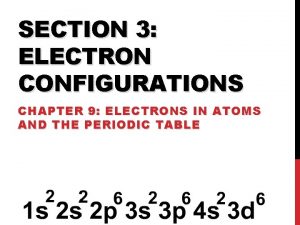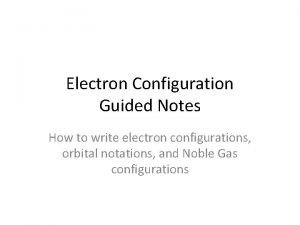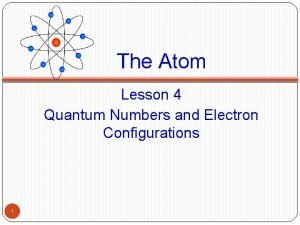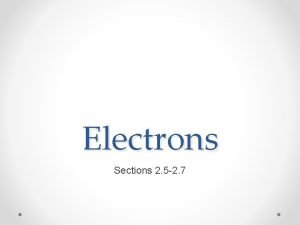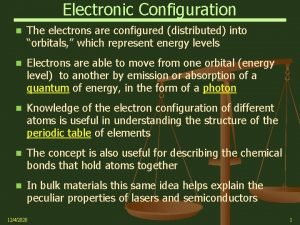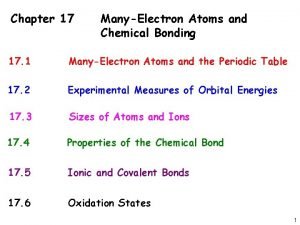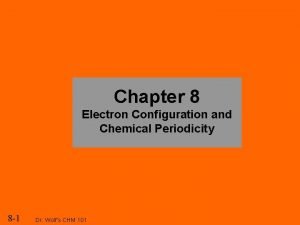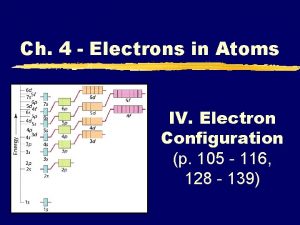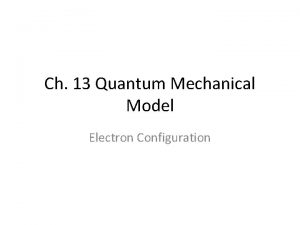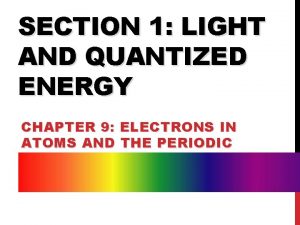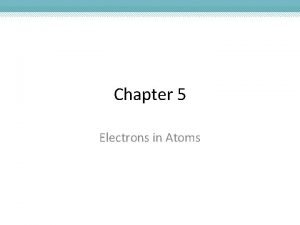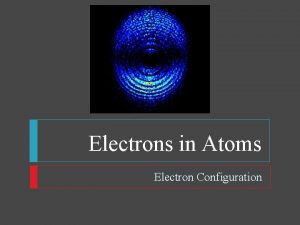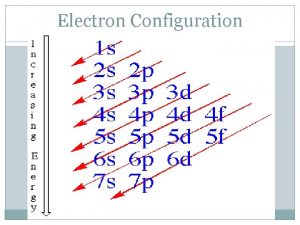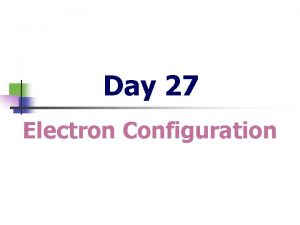Unit 2 Atoms and Light Notes Electron Configuration



















- Slides: 19

Unit 2 Atoms and Light Notes Electron Configuration and Light Equations

Lesson Vocabulary • orbital: The region in space in which an electron is most likely to be found. • quantum numbers: A series of specific numbers used to describe the location of an electron in an associated atom. • electron configuration: The set of orbitals occupied by electrons in a given atom. • ground state: The electron configuration of an atom in its neutral state in which the electrons occupy the lowest possible energy levels. • Aufbau principle: States that all lower energy orbitals must be filled before electrons can be added to a higher energy orbital. • Pauli exclusion principle: States that no two electrons in same atom can have the same set of four quantum numbers. • Hund’s rule: States that in a set of orbitals that are energetically equivalent, each orbital is occupied by a single electron before any orbital within the set is occupied by a second electron. • noble gas notation: A shorthand for the electron configuration of an atom in which the elemental symbol of the last noble gas prior to that element in the periodic table is written first, followed by the configuration of the remaining electrons.

Atomic Spectra • When excited by heat or electricity, the atoms of each element emit a specific, unique set of wavelengths of light-the atomic spectrum for that element.

Electrons and Light • Electrons are negatively charged subatomic particles buzzing around the nucleus in the electron cloud. • Electrons behave both as particles and waves, and so does light. • Light is visible light, the radiation that the human eye can detect on the electromagnetic spectrum. ROYGBIV

Niels Bohr • In 1913, Niels Bohr published his new model of the atom, locating the electrons in atoms in specific energy levels. • Bohr also theorized that when excited electrons jump to high energy levels, and when they drop back down to a lower energy level an electron emits a packet of electromagnetic energy-a photon. • A photon is a particle of light. • Then Max Planck came along and published his equation relating to specific amounts of energy to specific wavelengths (colors) of light. • Planck and Bohr opened the door for a more detailed study of the internal structure of atoms.

Excited State vs. Ground Sate • When an electron absorbs a quantum of energy causing an electron to move to a higher-energy orbital, it is in an excited state. • When all of the electrons of an atom are in their lowest-energy orbitals, the atom is said to be in the ground state. • Electrons tend to not stay in the excited state and when they fall back to the ground state they emit the energy that was absorbed by the atom in the form of one or more new photons.

The Electromagnetic Spectrum

The Visible Spectrum The visible spectrum runs through the colors of the rainbow -red, orange, yellow, green, blue, and violet. What is the relationship between wavelength, frequency, and energy in light?

Planck’s Equation • Light has both wave-like properties and particle-like properties. • Visible light travels in waves, we can calculate wavelengths of particular colors. • Light also consists of particles, photons, which are single packets of energy. We can determine the amount of energy in each packet, or photon.

Electron Configuration • The distribution of electrons in an atom. • The set of orbitals occupied by electrons in a given atom (exact definition). • Electron configuration provides a map of where each electron is likely to be located in a given atom.

Ground State • When an atom of an element is considered to be in the ground state, it is an electrically neutral atom, and its electrons are in the lowest energy locations.

Aufbau Principle • In order to determine the lowest energy electron configuration for a given atom, it is necessary to organize the atomic sublevels in order of increasing energy. • According to the Aufbau Principle, all lower energy levels must be filled before electrons can be added to a higher energy orbital. • The lowest energy sublevel is always the 1 s sublevel, which consists of one orbital.

Aufbau Continued The Aufbau Principle states that all lower energy orbitals must be filled before electrons can be added to a higher energy orbital. It is also sometimes referred to as the “building up” principle.

Follow each red arrow in order from top to bottom. This is an illustration of the Aufbau Principle.

Pauli Exclusion Principle • Each orbital can hold a maximum of two electrons, each of which must have a different spin.

Hund’s Rule • Hund’s rule states that, in a set of orbitals that are energetically equivalent, each orbital is occupied by a single electron before any orbital within the set is occupied by a second electron. • All electrons in singly occupied orbitals prefer to have the same spin quantum number.

Orbital Filling Diagrams • Provides a visual representation of the way in which atom’s electrons are distributed into various orbitals. • Each orbital is shown as a single square, and orbitals within the same sublevel are drawn directly next to each other. • Quantum number (energy level) and sublevel are the labels under each orbital. • Electrons are indicated by arrows and the direction the arrow is pointing indicates its spin direction.

Electron Configuration Notation • Shorthand version of the information contained in the orbital filling diagrams. Examples: Lithium has a configuration of 1 s 22 s 1 Beryllium has a configuration of 1 s 22 s 2 Carbon has a configuration of 1 s 22 p 2 *The BIG number represents the energy level (quantum number), the letter represents the sublevel, and the superscript represents the number of electrons in each orbital.

Noble Gas Notation • Group 8 on the periodic table are the noble gases. • Noble gases include helium, neon, argon, krypton, xenon, and radon. • For elements with large number of electrons, electron configurations can become quite long, so we abbreviate using noble gas notation. • The elemental symbol of the last noble gas prior to the that atom is written first, followed by the configuration of the remaining electrons. Examples: -Lithium is 1 s 22 s 1 , but can be written as [He]2 s 1. -Cesium is 1 s 22 p 63 s 23 p 64 s 23 d 104 p 65 s 24 d 105 p 66 s 1. Using noble gas notation, this becomes [Xe]6 s 1
 Electrons configurations
Electrons configurations Electron configuration vs noble gas configuration
Electron configuration vs noble gas configuration Electron configuration guided notes
Electron configuration guided notes Periodic table regents
Periodic table regents Light light light chapter 23
Light light light chapter 23 Into the light chapter 22
Into the light chapter 22 Light light light chapter 22
Light light light chapter 22 Quantum numbers and electron configuration
Quantum numbers and electron configuration Valence electrons in rubidium
Valence electrons in rubidium 5s 25p6 is the outermost electronic configuration of
5s 25p6 is the outermost electronic configuration of Chromium and copper electronic configuration
Chromium and copper electronic configuration Silicon paramagnetic or diamagnetic
Silicon paramagnetic or diamagnetic Orbital diagram for k
Orbital diagram for k C n o f electron affinity
C n o f electron affinity Stability and electron configuration ch 4
Stability and electron configuration ch 4 Quantum mechanical model and electron configuration
Quantum mechanical model and electron configuration Electrons in atoms section 1 light and quantized energy
Electrons in atoms section 1 light and quantized energy Electrons in atoms section 1 light and quantized energy
Electrons in atoms section 1 light and quantized energy Absolute vs relative configuration
Absolute vs relative configuration Chiral or achiral
Chiral or achiral
